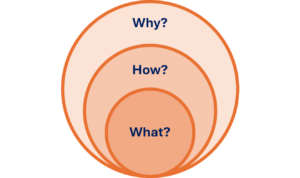
Great leaders don’t just lead—they inspire. This characteristic often means the difference between an organization’s success or failure. Without great leadership, corporate culture suffers, leading to employee apathy, high turnover, reduced productivity, lack of innovation, and a toxic work environment. These negative consequences can have a lasting impact on individuals and on the business.
In an earlier blog, we discussed Simon Sinek’s concept of “Start with Why” and how it can be applied to marketing initiatives. The same approach is effective when applied internally and helps leaders motivate action within their teams by communicating purpose. This concept offers a powerful framework for businesses looking to differentiate themselves and drive lasting impact.
The Golden Circle: Why, How, and What
Sinek’s “Golden Circle” framework is simple yet transformative. It consists of three concentric circles:
- Why: The core belief or purpose—why does your organization exist?
- How: The unique methods or processes that differentiate your organization—how do you fulfill that purpose?
- What: The specific products or services you offer—what do you do?

Often, leaders begin their messaging with “what” and “how.” Sinek, however, argues that starting with “why” inspires people on an emotional level, connecting them to a deeper purpose. It’s what separates effective leaders from their competitors and builds a loyal team of employees and other stakeholders.
Inspiring Leaders Start with Why
When leaders articulate a compelling “why,” they not only attract employees and clients who share their beliefs, they also foster greater commitment and loyalty. Sinek points to leaders like Steve Jobs and companies like Apple, which didn’t just market products—they communicated a belief in challenging the status quo and empowering individuals through innovation.
As a business leader, applying this principle can have a profound impact on both internal teams and client relationships. Here’s how:
1. Build a Unified Vision
Establishing and communicating a clear “why” unite team members around a shared purpose. This fosters collaboration, increases motivation, and aligns all efforts toward achieving common goals. When everyone understands the organization’s purpose and shares a vision for future success, they’re more likely to be passionate about what they do. This leads to higher-quality work and stronger customer service.
2. Communicate the “Why”
Communications that start with “why” resonate more deeply with audiences. Employees are drawn to leaders and organizations that are transparent and reflect their values and beliefs. When leaders understand and communicate the purpose behind their decisions and actions, it helps to engage and motivate team members. An organization’s “why” should be at the heart of every action and decision.
3. Lead By Example
Leaders who demonstrate integrity, self-awareness, and empathy set a standard for the entire organization. Leaders with integrity “walk their talk.” When a leader is self-aware, they monitor their emotions, strengths, weaknesses, and motives, and understand how they impact their leadership. Self-aware leaders continuously seek ways to create a supportive workplace that values everyone’s feedback. Empathy is an essential leadership skill that enables leaders to understand their employees’ needs and feelings. Empathetic leaders project a genuine concern for their teams, creating loyal and meaningful relationships.
4. Encourage Innovation and Growth
Great leaders inspire teams by encouraging innovation and personal and professional growth. Leaders can encourage team members to question the status quo, offer ideas for improvements, seek growth opportunities, and take risks. By doing so, they encourage their teams and businesses to stay relevant and succeed in an ever-changing business landscape.
The Impact of Starting with Why

When businesses start with why, they inspire action from employees, customers, and partners. It’s not just about what you do—it’s the bigger vision that drives everything your business is and does. By aligning your leadership efforts with this purpose, you’ll create stronger connections, boost loyalty, and differentiate your organization in a competitive marketplace.
As Sinek wisely put it, “People don’t buy what you do; they buy why you do it.” Purpose-driven companies have a unique competitive advantage. By embracing this mindset and leading with why, leaders can inspire teams, engage clients, and create a lasting impact in the B2B space.
The first step to great leadership is defining your purpose and sharing it with your team and other stakeholders. This simple act could be the game-changer your organization needs to inspire action and achieve long-term success.

